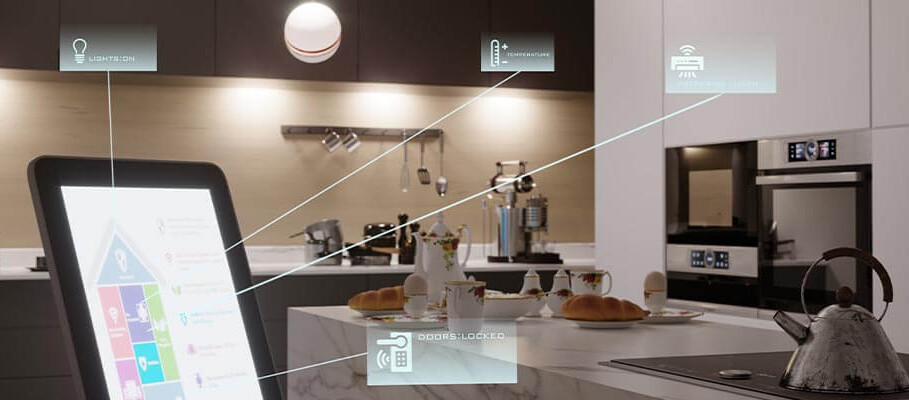Table of Contents
- Domotics Home Automation: What is it Exactly?
- Smart Home Technology: A Powerful Tool for B2Bs
- Emerging Trends in Domotics and Home Automation
- Environmental Benefits of Domotics: Energy Efficiency and Sustainability
- Seamless Integration: Domotics in Building Projects
- Technology House: Practical Applications for Businesses
- Partnerships in Domotics: Installers, Manufacturers, and Beyond
- Challenges and Considerations in Domotics Implementation
- Return on Investment: The Business Case for Domotics
- Pro Tip: Mastering Domotics Home Automation for a Competitive Edge
- Conclusion
1. Domotics Home Automation: What is it Exactly?
Domotics home automation refers to the integration of technology within a home to automate and control various systems and appliances. This includes lighting, heating, ventilation, air conditioning (HVAC), security systems, entertainment systems, and more.
The goal of domotics is to create a smart home environment that enhances comfort, convenience, security, and energy efficiency.
Domotics systems are designed to be user-friendly, often controlled through a central hub, smartphone app, or voice commands. For example, a domotics system can automatically adjust the thermostat based on occupancy, turn off lights when a room is empty, or send security alerts to a homeowner's phone.
Security is a cornerstone of domotics, providing homeowners with peace of mind and enhanced protection:
- Through integrated systems, users can monitor and control security cameras, motion detectors, door and window sensors, and alarm systems remotely.
- Smart locks can be programmed to automatically lock and unlock based on schedules or user proximity, while real-time alerts can notify homeowners of any suspicious activity.
Furthermore, these systems can be integrated with other smart home features, such as lighting, to simulate occupancy when the house is empty, deterring potential intruders.
2. Smart Home Technology: A Powerful Tool for B2Bs
Smart home technology offers significant advantages for businesses, particularly in the construction, real estate, and property management sectors.
By incorporating domotics into their projects, B2Bs can differentiate themselves from competitors, attract more clients, and increase property value. For instance, a construction company specializing in smart home integration can offer state-of-the-art homes that appeal to tech-savvy buyers.
Similarly, a property management company can use domotics to improve building efficiency, reduce operational costs, and enhance tenant satisfaction. They can also attract buyers by highlighting the cost-saving nature of the built-in home automation.
Smart home technology is no longer a luxury; it's becoming an essential component of modern buildings.
3. Emerging Trends in Domotics and Home Automation
The field of domotics and home automation is constantly evolving, with new technologies and trends emerging regularly:
- One significant trend is the increasing use of artificial intelligence (AI) and machine learning (ML) to create more intuitive and personalized smart home experiences. AI-powered systems can learn user preferences and behaviors, automatically adjusting settings and providing proactive recommendations.
- Another trend is the growing emphasis on interoperability and open standards, allowing different domotics devices and platforms to communicate and work together seamlessly.
- Additionally, voice control is becoming increasingly popular, with virtual assistants like Amazon Alexa and Google Assistant playing a central role in smart home management.
- The rise of 5G technology is also expected to accelerate the adoption of domotics by providing faster and more reliable connectivity for a growing number of connected devices in the technology house.
If you are a domotics or home automation professional, request a consultation with our team to see how you can offer your services or products on our platform and reach a vast network of potential B2B clients.

4. Environmental Benefits of Domotics: Energy Efficiency and Sustainability
Domotics and home automation play a crucial role in promoting energy efficiency and sustainability.
Smart home systems can optimize energy consumption by automatically adjusting lighting, heating, and cooling based on occupancy and environmental conditions. For instance, smart thermostats can learn a building's heating and cooling patterns and adjust temperatures accordingly, reducing energy waste.
Domotics can also integrate with renewable energy sources, such as solar panels, to maximize their use and reduce reliance on the grid.
By reducing energy consumption, domotics not only lowers utility bills but also contributes to a smaller carbon footprint. This focus on environmental benefits is increasingly important for businesses seeking to demonstrate their commitment to sustainability and attract environmentally conscious clients.
For more information about energy efficiency in building projects read these insightful articles:
- How AI is helping companies manage the energy transition
- Long-term storage for green electricity: the current technologies
- Water batteries: more sustainable and less toxic
- Heat Pumps: Technology of the future?
- Agenda 2030: 17 Sustainable Development Goals
- Smart air conditioning control: features and benefits
- Why Wood is Back in Modern Architecture
5. Seamless Integration: Domotics in Building Projects
Integrating domotics into building projects, whether residential or commercial, demands a proactive and meticulously planned approach that goes far beyond simply adding smart devices after construction is complete.
Successful integration requires careful planning and close collaboration between architects, builders, electricians, and domotics specialists from the very outset of the project. The key is to design the smart home system concurrently with the architectural and structural plans, ensuring that the necessary infrastructure is seamlessly integrated into the building's fabric.
This forward-thinking approach allows for optimal placement of wiring for low-voltage systems essential for many domotics components. It also facilitates the strategic installation of smart switches, outlets, and control panels, ensuring they are both functional and aesthetically integrated.
Furthermore, a robust and reliable network infrastructure, capable of supporting the bandwidth demands of numerous connected devices, needs to be designed and implemented. This often involves considering both wired and wireless network solutions to guarantee seamless connectivity throughout the building and to avoid future retrofitting that can be costly and disruptive.
Builders play a pivotal role in bridging the gap between design and execution. They need to work closely with specialized domotics installers, fostering a collaborative environment where expertise is shared.
This ensures that the chosen domotics system is not only properly installed but also meticulously configured and rigorously tested to meet the specific needs and expectations of the client. This collaborative relationship helps to prevent potential conflicts between different trades and ensures that all components work harmoniously.
Beyond the technical aspects, educating clients about the features, benefits, and operation of their new smart home system is crucial for a smooth transition and successful user adoption. This involves providing comprehensive demonstrations, user-friendly manuals, and ongoing support to empower clients to fully utilize the capabilities of their domotics system.
Finally, forward-thinking builders and installers will also consider future scalability and potential upgrades. The rapidly evolving nature of technology means that anticipating future needs and designing a system that can adapt to new devices and functionalities is vital for long-term client satisfaction and avoiding obsolescence. This might include provisions for additional wiring, extra network capacity, and compatibility with evolving industry standards.
This proactive consideration of scalability protects the client's investment and positions the building for future technological advancements.
6. Technology House: Practical Applications for Businesses
The technology house concept extends beyond residential applications and offers numerous benefits for businesses:
- In office buildings, domotics can automate lighting, HVAC, and security systems, improving energy efficiency and reducing operational costs.
- Smart conference rooms can be equipped with automated audio-visual systems, enhancing productivity and collaboration.
- In retail spaces, domotics can be used to create interactive displays, manage inventory, and optimize energy usage.
- Hotels can leverage smart home technology to offer personalized guest experiences, such as automated room controls and customized entertainment options.
The applications of domotics in the B2B sector are vast and continue to expand as new technologies emerge.
7. Partnerships in Domotics: Installers, Manufacturers, and Beyond
Successful domotics implementation often relies on strong partnerships between various stakeholders.
Builders and developers need to collaborate with experienced domotics installers who can design, install, and maintain smart home systems. They also need to establish relationships with reputable manufacturers of domotics devices and platforms.
These partnerships ensure access to high-quality products, technical expertise, and ongoing support. Additionally, businesses may need to partner with software developers to create custom applications or integrate domotics systems with other business software. Collaboration is key to delivering seamless and effective domotics solutions.
To begin sourcing the right partners and products for your next project, you can submit a request for a quote on our platform.

8. Challenges and Considerations in Domotics Implementation
While the benefits of domotics are numerous, there are also challenges and considerations to keep in mind:
- One potential challenge is the initial cost of implementing a smart home system, which can be higher than traditional systems. However, it's important to consider the long-term cost savings from energy efficiency and other benefits.
- Another challenge is ensuring the security and privacy of domotics systems, as they are connected to the internet and collect data about user behavior. It's crucial to choose reputable manufacturers and installers who prioritize security and follow best practices for data protection.
- Businesses should implement robust security measures, such as strong passwords, encryption, and regular software updates, to protect their smart home systems from cyber threats.
Addressing these challenges proactively is essential for successful domotics implementation.
9. Return on Investment: The Business Case for Domotics
Investing in domotics can bring a significant return on investment for businesses. Energy savings from automated lighting, heating, and cooling systems can lead to lower utility bills, reducing operational costs over time.
Smart home features can also increase property value, making buildings more attractive to potential buyers or tenants.
Additionally, domotics can improve efficiency and productivity by automating routine tasks and providing valuable data insights. For example, a smart home system can track energy consumption patterns, identify areas for improvement, and optimize building performance.
The long-term benefits of domotics often outweigh the initial investment, making it a worthwhile investment for businesses.
10. Pro Tip: Mastering Domotics Home Automation for a Competitive Edge
Stay ahead of the curve by focusing on continuous learning and adaptation in the rapidly evolving field of domotics.
Partner with industry experts and attend relevant conferences or webinars to gain insights into emerging trends and best practices. This knowledge will empower your business to offer cutting-edge smart home solutions that meet the evolving needs of clients and provide a strong competitive advantage in the market.
11. Conclusion
Domotics home automation is transforming the building industry, offering numerous benefits for B2B professionals. From enhancing energy efficiency and sustainability to improving building performance and increasing property value, smart home technology is becoming an essential component of modern construction projects.
Understanding the latest trends, practical applications, and challenges of domotics allows businesses to leverage these advancements, gain a competitive edge, and deliver greater value to their clients.
As the technology house concept continues to evolve, embracing domotics is no longer an option but a necessity for businesses seeking to thrive in the future of building.
What new innovations in domotics will emerge in the next five years, and how can businesses prepare for them? The companies that proactively adopt and adapt to these changes will be the ones that define the next generation of building and construction.
Find home automation solutions for your Project!
- HOMCREA (JBCL)transforms properties into smart homes with comprehensive home automation system installations. They offer security assessments, intelligent camera and detection system installations, and remote control of heating, air conditioning, and lighting, resulting in enhanced security and energy savings.
- DIALOGOS DI M.RELLA offers comprehensive IT solutions, including specialized industrial home automation systems. They also provide hardware and software sales, installation, and support, encompassing video surveillance systems, alongside broader IT services like custom AS400 programming and a cloud-based management solution for the waste sector.
- STE STORE VOLET FRANCE specializes in home automation, utilizing interoperable technologies from electronics, building physics, automation, computer science, and telecommunications. They centralize control of various building systems, including heating, shutters, and access points, providing solutions for comfort, security, and communication needs in residential, hospitality, and public settings.
- GLORY INJECTION PLASTIQUE offers custom manufacturing of complex thermoplastic parts. They excel in mono-, bi-, and tri-injection processes, serving diverse sectors including home automation, automotive, and healthcare, with capabilities for both small and large production runs.
- GRUPO BRELLO provides innovative and customized components for the home automation sector. They specialize in manufacturing high-quality parts for smart home devices, utilizing advanced techniques like multi-component injection and offering design, development, and rigorous quality control to meet the unique demands of this rapidly growing industry.
- Filplast Sp. z o.o. is a leading Polish manufacturer with over 30 years of experience, offering custom-made, energy-efficient windows, doors, and automated roller shutters. They provide high-quality, durable solutions for both individual and B2B clients, including specialized products like aluminum facades and bullet-proof windows.
- SMARTSECURITY provides comprehensive video surveillance and anti-intrusion alarm solutions for businesses of all sizes. Their turnkey services include security audits, custom system design, installation, maintenance, and 24/7 support, utilizing cutting-edge technologies and ensuring compliance with industry standards. They are committed to customized solutions, continuous innovation, and customer satisfaction.
- ARNOLD STEINMÜLLER STANZTECHNIK specializes in cost-effective manufacturing methods for sheet metal assemblies commonly used in building technology. Their expertise encompasses a wide range of applications, including HVAC systems, water supply components, and door and window fittings.
- B & W ENERGY GMBH & CO. KG is a leading provider of renewable energy systems, offering intelligent energy solutions for industry, commerce, and individuals since 2003. With over 8,500 photovoltaic and 800 energy storage systems installed, they provide comprehensive services from planning to implementation, specializing in photovoltaics, energy storage, roof space leasing, and charging infrastructure. They are known for creating customized solutions that can help reduce rising energy costs.

